Aphids, mealybugs, whiteflies and scale may be the most common insect pests that you will find on your houseplants but there are several other pests and problems you should watch out for. Some of these pests are so tiny that you may never have seen them until you really take a close look or use a hand lens or magnifying glass to boost your vision.
Thrips
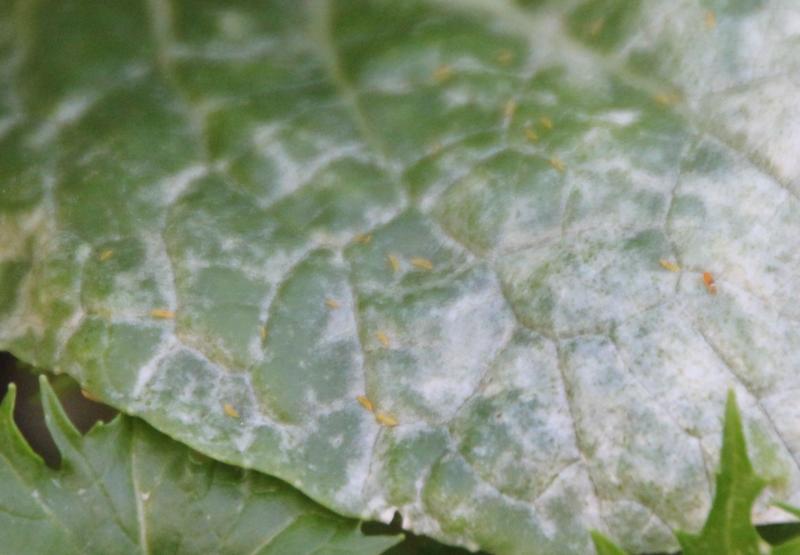
The first is a tiny insect called thrips. Thrips have become a huge pest in greenhouse crops and are also very common on outdoor plants. They are really small, about 1-2 mm long and have narrow, cigar-shaped bodies. When they reach adulthood they actually develop fine, feathery wings but those are almost impossible to see. They are usually yellow-tan to brown. They feed by piercing plant cells then sucking up the plant sap. They also sometimes inject digestive juices which can cause further damage. Thrips feeding can cause a silvery appearance on leaves. Thrips also commonly feed on flowers. If you see white streaks in colored flowers and the flowers are somewhat malformed it could be thrips damage.
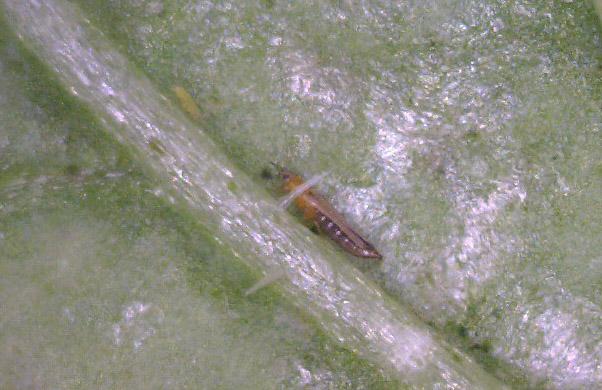
Thrips damage plants in another very important way - by vectoring diseases, including a number of viral diseases. These diseases can be quite devastating when they progress through a greenhouse full of plants, which might then need to be destroyed. One particular thrips species, the Western Flower thrips, has developed resistance to most of the commonly used insecticides that once controlled it. So new control strategies need to continually be developed to keep up with this notorious pest.
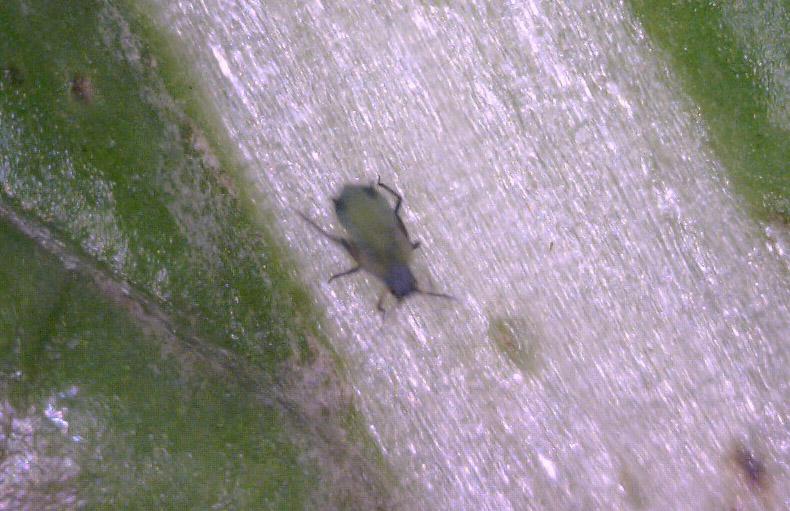
Most plant-damaging species of thrips do not survive our winters and they are not good flyers. But, because they are so light weight and multiply so rapidly they are readily blown up from southern states with spring and summer storms. They are also transported on infested plants. Thrips also live year around in commercial and home greenhouses so it is fairly easy to bring them into your home. If you had your plants outside during the summer, or even had your windows open, they could come into your home that way too – they can crawl right through a window screen.
So how do you look for thrips on your plants? Generally plants that have thick, tough or leathery leaves are not very likely to be bothered by thrips. Look for the silvery patches or streaks on leaves and flowers. I suggest checking out any flowering plants that you have. I have found that if you gently blow into a flower it will make the thrips move around a bit, maybe come out of hiding, so that you can spot them. You can also hold the flower or a leaf that looks like it might have thrips damage, over a piece of paper and give it a good tap with your finger. This might dislodge any thrips that might be present so that they drop down onto the paper, where they will be easier to see.
Thrips control is difficult as I mentioned earlier, especially in a houseplant situation. Heavily infested plants should be discarded. Removing infested flowers and buds can also help. Insecticidal soaps, horticultural oils and
Spider Mites
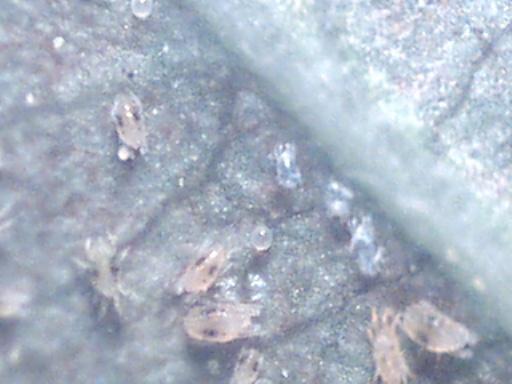
Spidermites are likely the smallest plant pest you will encounter, not counting microorganisms like fungi, bacteria or viruses. These tiny pests are actually arachnids, related to spiders, so they have eight legs instead of six and they can make minute webs like spiders do too. Like most of the houseplant pests, they feed on plant sap, usually on the underside of leaves. When a spider mite feeds on a plant cell, that cell turns yellow or brown. Since spider mites usually feed in large numbers, a plant with spider mite damage will have foliage with a bronzed or speckled appearance. You may also notice the tiny webs in the axils of leaves or around young shoots or even flower buds in a heavy infestation. The mites are very small, barely visible to the unaided eye. The two-spotted spider mite is the most common houseplant pest. It is tan with two spots on its back and less than a millimeter in size. Spider mites lay tiny light yellow eggs that can hatch in just a few days releasing the mite that can mature in less than a week. Female mites can lay hundreds of eggs in their lifetime so infestations can grow very quickly.
Most mites prefer a warm and dry environment, typical of most homes during the winter months when relative humidity is usually at its lowest. Plants growing in hanging baskets near warm air ducts are particularly vulnerable. English ivy (Hedera helix), for example, makes a great hanging basket plant but is also very susceptible to spider mites. Check your plants carefully for spider mites. Look for the bronzed foliage, webbing, as well as the mites and eggs. Use a hand lens or magnifying glass to examine the undersides of the leaves if they look like they might have mites. You can also give leaves or shoots a good tap over a piece of paper to dislodge the mites and make them more visible on the paper. Look for little dust-size specks that might be moving across the paper. You can also do the smear test by wiping your finger over the paper to crush and smear the mites across the page – a little gruesome but it can make them easier to see.
Usually people find out they have an infestation by first noticing the webbing, which can engulf whole parts of a plant. Several years ago, for one of my classes we were growing roses in the greenhouse under HID lights, which put out a lot of heat. One day I was shocked to see the top several inches of several plants completely wrapped in webs with thousands of spider mites feeding happily in the warm environment. Needless to say we had to take some immediate and drastic action to get them under control.
Controlling spider mites can be difficult. Heavily infested plants should be discarded. Mites are easily transferred to other plants by air movement in the home or by “hitchhiking” on your clothing as you tend to your plants. If you find that just a few parts of a plant are most affected, you can prune those parts off in hopes of saving the rest of the plant. The webbing that spider mites produce protects the colony of mites from predators as well as treatment by most sprays. Use a forceful jet of water to dislodge the webs and mites. Horticultural oils and insecticidal soaps for use on houseplants are usually the best types of sprays to use. Lastly, try moving plants to a cooler location and increase humidity with a humidifier, a pebble tray partially filled with water or frequent misting.
Overwatering & Excess Salts
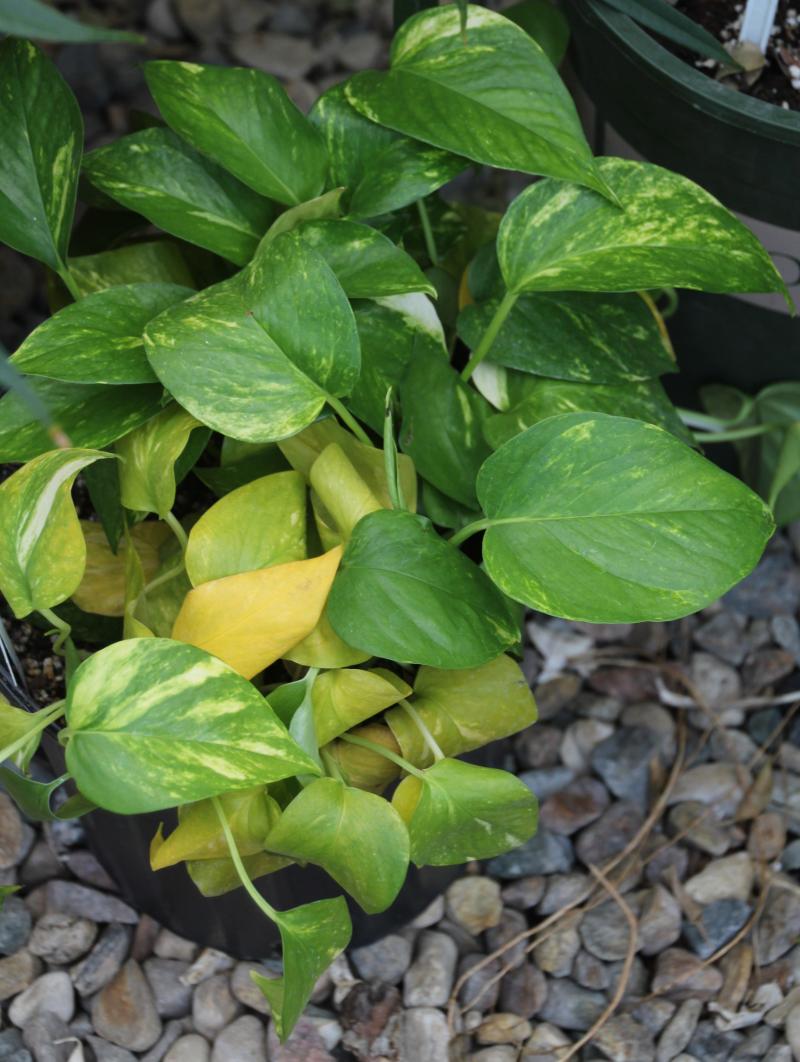
Moving from the smallest, 8-legged pest to what is often the largest pest problem of houseplants that only has two legs– you! Overwatering is the number one killer of houseplants, a far more serious problem than the other pest problems discussed so far. I think the second most common problem, also associated with watering, is excess salt accumulation in the potting soil which makes plants look stressed, wilted and often leads to various root problems that can cause a long, lingering death of plants. The excess salts can accumulate on the soil surface, the rim and sides of the pot as well as the saucer, making for a pretty disgusting mess.
The best strategy to avoid either of these two problems is pretty simple. Only water a plant when it needs it; when you do water it, water it thoroughly. And lastly, do not let plants sit in water, particularly the water that might drain out of the bottom of the pot after you water it. So how do you know when a plant needs water? The best way to tell is to feel the potting soil by sticking your finger into it. If it feels moist, do not water the plant. Wait another day or two and check it again. When it feels dry down to the first inch or so, then water it. Apply enough water so that the excess will come out of the bottom of the pot. Probably the best thing to do is place the plant in your sink and water it there. That way the excess can just drain down into the sink. When it quits dripping, place it back in its usual place. If you let the excess drain into a saucer, empty the saucer then replace the plant on the saucer.
Remember that overwatering usually has more to do with frequency than amount. You cannot overwater a plant if you allow the excess to drain out of the bottom of the pot, in fact it is good to do that to help dissolve and “leach” out excess fertilizer salts in the potting soil. Overwatering is much more likely if you water your plants a little bit every day because the potting soil may never dry out enough to allow enough air into the soil to provide the oxygen roots need to survive. Immediately watering a wilted plant is not a good idea even though wilting is a sign of water stress. That water stress may occur because overwatered plants have lost their roots, not just because the potting soil got too dry. Yellowing leaves may also be a sign of overwatering or loss of roots. Knock the plant out of its pot to check the condition of the roots, they should be nice and white in color, not dark brown, black or mushy.
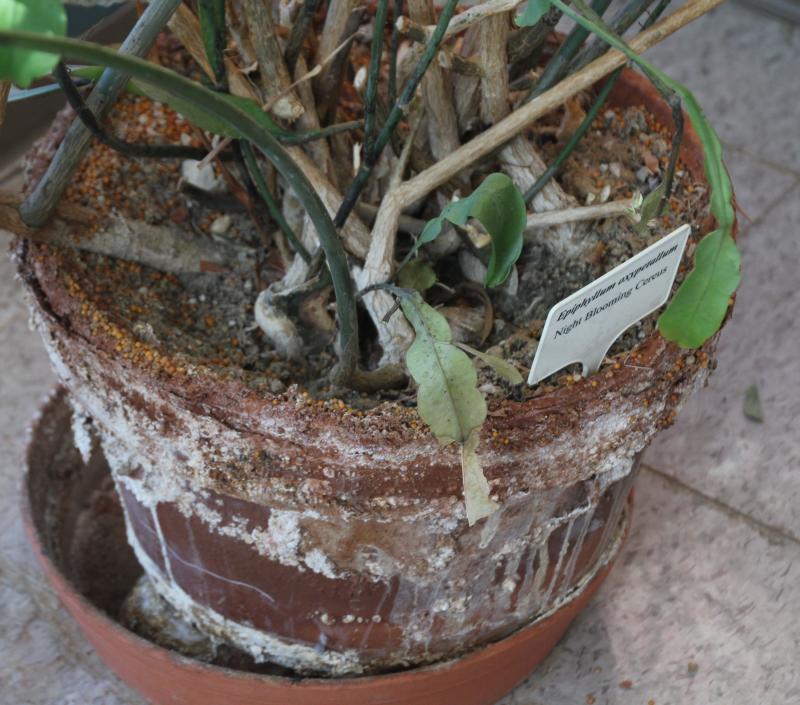
If a plant has a real problem with excess fertilizer salts, repotting is probably the best solution, removing much of the old potting soil and using a fresh pot in the process. Leaching out the salts can also be accomplished by setting the plant in the sink and slowly running cool water into the pot. The outside of the pot and interior of the saucer should also be scrubbed up before returning the plant to its growing location. Then try to more carefully water the plant in the future.


